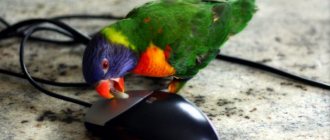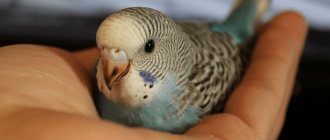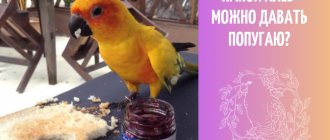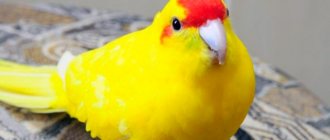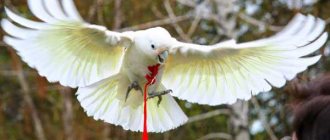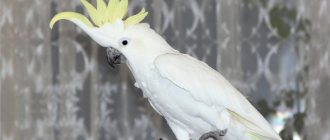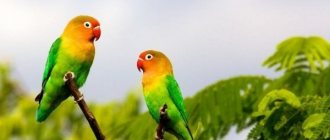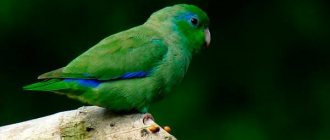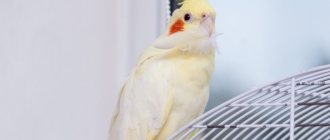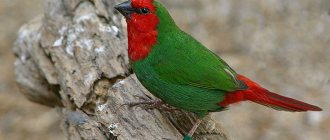Online magazine about parrots
Colors and patterns of budgies
We have translated and compiled for you a guide to the colors and patterns of budgerigars
Look
Popular article
Let's figure out how to choose a mate for a male or female budgie
2
Home › General
The first thing a person who decides to get a winged pet will think about is a budgie. The bird market offers more than 200 subspecies of these animals. Thanks to breeders, you can find a wide variety of budgies on sale: small, large, blue, yellow, albino and others.
If we take into account the data of ornithologists, the number of domestic species has long exceeded the number of wild ones. But before you get a bird, you should evaluate all the points.
In the article we will consider situations when a parrot is at home, the pros and cons of keeping a bird in an apartment.
- Benefits - what does a bird give to a person? Conversations
- Attachment
- Ease of keeping in an apartment
- Quick wits
- Allergy
- Cell
What is the best parrot to get?
There are more than 350 species of parrots in nature. Most of them live only in nature. Domestic parrots differ from their wild counterparts in their calmer disposition. Among the variety of all breeds, it can be quite difficult to decide which parrot is best to get. Each species has its own characteristics and abilities, and also differs in character and behavior.
Which parrot is better to get:
- For children and beginners, small and medium-sized types of parrots are suitable: budgerigar, cockatiel, lovebirds, necklace parrot, kakariki.
- For experienced poultry keepers, larger species are suitable: African Gray, Macaw, Cockatoo, Amazon, Rosella.
Parrots are often kept for children so that they learn care and responsibility. In this case, it is not recommended to choose large species of parrots, since they are demanding in terms of care and maintenance.
Even experienced owners do not keep some types of large parrots, since it is quite difficult and expensive to provide them with comfortable living conditions. Before deciding which parrot is worth purchasing, you need to take into account your financial capabilities and evaluate the conditions for keeping the parrot.
To keep a parrot you will need:
- Cage or spare room. The cage for small and medium breeds is chosen according to the size and number of parrots. It is important to choose the right place for the cage in the apartment. Large parrot species such as cockatoos and macaws are not recommended to be kept in a cage at all times. A free room is usually allocated for them, and they need a cage mainly for resting and feeding.
- Drinking bowl and feeders. You can purchase plastic drinking bowls and feeders for small breeds of parrots. For large species, metal ones are usually used because they have a large and strong beak, with which they can easily and quickly chew through plastic and wood.
- Perches can be made of plastic, wood or rubber. Plastic perches are often included with the cage, but their use is not recommended. Rubber perches should not be used for large parrots, as he will chew them and particles of rubber will enter the digestive system. The best option would be to choose wooden perches. Their thickness should correspond to the size of the parrot.
- Bathhouse. For small breeds, use a bowl or small container. For larger ones, a small bowl of water is suitable.
- Toys for a parrot are a must-buy. Special playgrounds are often installed. It is worth considering that toys will periodically get chewed and should be updated.
- Feed and mineral supplements. For each type of parrot, you need to purchase specialized food. Do not feed grain mixture to cockatoos if it is intended for budgies. Each specialized food contains the necessary nutritional composition specifically for the corresponding type of parrot. Before getting a parrot, it is better to find out the prices for basic food.
It is very important to choose a young and healthy individual. If a parrot sits silently in a cage and does not pay attention to others, it may be sick. You should also be wary of a parrot that sits ruffled.
It is worth paying attention to the appearance of the parrot. The plumage should be even and smooth, there should be no ruffled feathers. There should be no peeling or growths on the beak and paws. The eyes should be bright and the cloaca clean.
Let's look at the most popular types of parrots to keep at home.
Negative aspects of the content
Like any other pet, budgies have their downsides. They need to be weighed before purchasing the bird. In addition, for some, the disadvantages can be critical.
Allergy
Any bird is down and feathers. The budgerigar is no exception. The best option is to have allergy tests done by a specialist. If your friends have a bird, you can take it in for a while to determine the attitude of household members towards down and feathers.
Garbage
Food, droppings and husks scatter about a meter from the pet’s home. That is, in addition to cleaning the cage itself, you will have to clean the surrounding area. And these may be household appliances, furniture cracks and other hard-to-reach places.
Sounds
Budgerigars are quite noisy animals. They constantly chatter, coo and chirp, especially if they are in company.
Throwing fabric over the cage, as is the case with larger specimens, does not help here. If you are not ready to get up with them at six in the morning, then it is better not to have such pets.
Although with rare exceptions, some birds get psittacosis. This infection is transmitted to humans. In this case, the owner will have to seek help from both a veterinarian and a clinic.
Space
The bird needs walks. At least once a day, the pet should fly freely around the room. Given the playful nature of budgies, they can begin to “play” with expensive furniture and appliances , gnawing cords, picking off embossing, and also damaging flowers.
Budgerigar
An excellent option for children and for those who first decided to have a parrot in the apartment. This is the most popular and common type of parrot for home keeping. The budgerigar is unpretentious and does not require care and maintenance. To keep one individual you will need a cage 40 by 60 cm.
They are small in size from 12 to 18 cm, live 10-15 years. Prices for such a parrot start from 500 rubles.
Budgerigars are very cheerful, playful and sociable birds. They bite extremely rarely and do not hurt; they are easy to tame. A budgerigar can also be taught to talk.
What does a healthy bird look like?
A sick parrot is not as scary as you might think. But you cannot bring a sick individual into a house where other birds live - it will infect everyone. So how to choose and buy a healthy parrot? Carefully consider his appearance and behavior. Indicators of a successful bird:
- shiny, dense plumage;
- eyes are clean, not cloudy;
- cere without cracks and growths;
- smooth, clean beak;
- smooth skin on the paws;
- proud posture;
- The cloaca area is neat, covered with feathers.
A well-groomed parrot should be well-fed and active. When sitting on a perch, the paws are spread wide and grasp firmly with four toes. If there have been injuries, fractures, the bird has difficulty maintaining its balance and walks awkwardly.
Lovebirds
Suitable for busy people who have little free time. It is best to have a couple of lovebirds, then they will be busy with each other all the time. In the absence of a mate, the lovebird requires attention and becomes very attached to the owner.
It is not recommended to keep parrots in the same cage with other species. They can behave aggressively towards another species and cause damage.
The size of the lovebird is 10-17 cm, lives 10-15 years. Prices for one individual start from 1,000 rubles.
How to find a talking parrot
Budgerigars are able to remember words that a person says and reproduce them without reference to the situation. What to look for and how to choose a budgie to talk to?
- Gender is important: boys learn faster and speak more willingly than girls.
- Good health - an active and cheerful bird is in the mood for chatter.
- The young chick becomes strongly attached to its owner and trusts him boundlessly.
- Individuals with natural colors are the most talkative. Rare mutations, especially albinos, have difficulty speaking.
- Weak chicks abandoned by their parents are the best students. Growing up under the care of a “nanny,” they absorb information and begin to speak early.
Gender, age, health are the main criteria for learning ability. Boys aged 8 - 10 months are ideal for training. It turns out that choosing a parrot to talk to is not so difficult. Affectionate treatment will help consolidate the results.
Ruffled parrot
A very intelligent and friendly type of parrot. Males have a dark necklace-like stripe around their necks. Because of this feature, this species got its name. Females do not have such a stripe.
The size of the parrot is 35-45 cm, they live 20-30 years. Price from 15,000 rubles.
A large cage or enclosure is required for maintenance. Easy to tame and highly trainable. They train well and can be taught to talk. Of the minuses, it should be noted that this parrot makes loud sounds that are unpleasant for many.
Owner reviews
In general, budgies receive positive reviews. But some owners, alas, face serious difficulties.
We bought it for our child after watching the cartoon “Rio”. The bird is completely picky and eats everything. A sea of positive emotions and positivity. The only drawback is feathers all over the kitchen
Lina, Simferopol
Beautiful, smart and extremely curious animals. Great as an alarm clock. It’s better not to take children, you have to look after it yourself
Larisa, Moscow
Doesn't let you get bored on dreary evenings. The bird is always cheerful and cheerful. There are never any problems with feeding or cleaning. The only downside is that there is only trash around the cage.
Vika, Tula
The parrot lived with us for exactly two months before molting. The children developed an allergy to fluff and had to give it to a friend
Elena, Krasnodar
Jaco
The African Gray Parrot is suitable for experienced bird keepers. Very smart and artistic birds. They are able to imitate human speech and funny imitate pets.
Size 30-35 cm, live 40-60 years. Prices for grays start from 60,000 rubles.
The purchase of this type should be taken seriously. They require a lot of attention. Grays need to be handled and trained, otherwise they can become aggressive and daring. When choosing an African gray parrot, you should pay attention to its behavior. He must be tame and must not show aggression.
How to choose a male budgie
Male budgerigars are more often adopted: it is believed that they are more active, cheerful, and easier to tame. It is easier to teach a boy to speak, and the ability to imitate human speech is one of the most attractive qualities.
Often gender is quite obvious. Females and males do not differ particularly in plumage; the main external sexual characteristic is the color of the wax. In mature females it is brown or beige, in males it is purple. In young birds that have not gone through the molting stage, gender is diagnosed with low probability. Even the seller cannot always tell you exactly.
Note: a wavy boy can be recognized by observing his behavior. The male will sing a lot, shake his wings frequently, and sit on top of other birds.
Is it worth getting a parrot?
Before getting a parrot, you need to carefully weigh the pros and cons of whether it is worth getting a parrot. You should also evaluate your capabilities. Both time and financial costs will be required.
Among the advantages of keeping small parrots, it can be noted that they take up little space, you do not need to walk with them every day, you can leave the parrot unattended for a couple of days. Large species of parrots are a source of pride for the owner. Experienced breeders try to acquire the rarest species with bright, unusual plumage.
If you have no experience communicating with birds, it is worth getting a small parrot that does not require special care and special conditions. Often, in pursuit of fashion, people try to immediately purchase a large and expensive parrot. But without the knowledge and skills to keep such parrots, the birds often suffer from unsuitable living conditions and often get sick, which leads to premature death.
When choosing a parrot, the main thing is to evaluate your strengths and pay attention to the bird. It is important that your parrot is active and healthy. Then he will delight all family members throughout his life.
How to prepare to buy a parrot
Getting a small parrot is as easy as shelling pears: now pet stores are full of different birds, food, and accessories for keeping them. The prices for all this stuff are affordable. Before you start choosing a parrot for your home, you need to think things through. It’s worth discussing your wishes with your family and not forgetting a single detail:
- Watch the video. Even little ones like wavy creatures litter and make noise. They wake up at dawn and chirp all day. Flying around the apartment, they leave droppings behind them, tear off wallpaper and curtains. They spoil documents, books, gnaw flowers.
- Evaluate the space. Select the location where the cage will be located. The wavy does not need a large home, but it still needs freedom. The maintenance rules stipulate that the cage should be kept away from windows, batteries and household appliances. At the same time, parrots do not like to be moved from place to place. Birds should have a permanent corner.
- Make time. Sociable birds require attention; they get bored without people. If you don't have even one free hour a day to talk to, pet, and train your parrot, don't get a pet. Loneliness and then depression await him.
- Select the sex and number of birds. With plenty of time to spend, take one wavy boy. Males learn better and imitate speech. Females are shy and less attached to their owner. Two same-sex birds often quarrel, while opposite-sex birds create a family and raise chicks.
- Collect a first aid kit. It’s not enough just to provide care items and medications; you also need to write down the address and telephone number of the nearest veterinary clinic. The feathered ward will have to be treated, vaccinated, and taken for preventive examinations.
Attention! The down and feathers of budgies provoke an allergic reaction. If anyone in your family is prone to allergies, do not buy the bird.
When all the pros and cons are weighed, and the decision is made that you are buying wavy, it’s time to go to the trading places.
Allergies to feathers, droppings and even poultry products
Before making hasty conclusions about allergies, you need to first understand the reasons, because sometimes allergies can arise from dusty bedding in a cage, food, parasites in a parrot’s feathers, or droppings. Try to exclude the possibility of allergies from the very first day:
- remove the tray and wipe the cage from dust and feathers as often as possible;
- examine the bird for parasites;
- select feed and bedding for poultry, taking into account the possibility of allergies to their components.
Parrots for children and beginners
Many parents get birds at the request of their children. Usually, when choosing a parrot, they are guided by their living conditions, financial capabilities and the age of the child. Of course, mistakes happen. Children are not always ready to constantly care for a pet, or they purchase a bird that is too large and cannot create the necessary conditions for it.
In the best case, it is possible to return the bird to the breeder from whom it was purchased, to the pet store, or to be placed in good hands. At worst, they practically forget about the bird, sometimes they only remember that it needs to be fed and the cage cleaned of dirt. In poor conditions, the bird, acutely aware of its loneliness and uselessness, becomes depressed, begins to pluck its feathers, becomes seriously ill and dies.
Therefore, so that the bird does not become unhappy, and your family does not suffer from its presence, familiarize yourself in advance with the breed of the parrot that you are going to get.
Which parrot is best suited for an apartment with a child? If the apartment is small, what kind of bird can feel free in it? Will your finances allow you to regularly purchase expensive food that, for example, cockatiels or Grays need?
You must answer these questions before purchasing a bird, and then your home will not just have a pet, but a real family member, enjoying the love of others and giving only positive emotions.
Adaptation period and quarantine before moving into one cage
If you are not sure that the newly purchased bird is absolutely healthy, it is better to keep it in isolation, that is, in quarantine. It should range from 2 weeks to a month. You should install the cage with the newcomer not close to your pet, but in another room - to avoid accidental infection during a walk.


